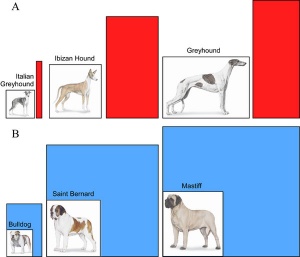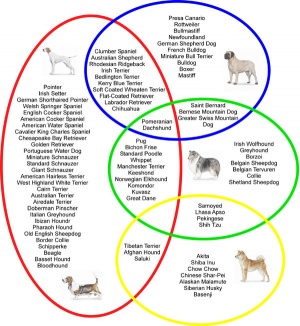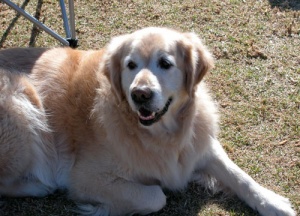Dog Development: Difference between revisions
| Line 81: | Line 81: | ||
| '''Female Urogenital''' | | '''Female Urogenital''' | ||
|} | |} | ||
<ref><pubmed>12840810</pubmed></ref> | |||
Mol Reprod Dev. 2003 Aug;65(4):373-81. | |||
Sry and Sox9 expression during canine gonadal sex determination assayed by quantitative reverse transcription-polymerase chain reaction. | |||
Meyers-Wallen VN. | |||
James A. Baker Institute for Animal Health, College of Veterinary Medicine, Cornell University, Ithaca, New York 14853, USA. | |||
Abstract | |||
Testis induction is associated with gonadal Sry and Sox9 expression in mammals, and with Sox9 expression in vertebrates where Sry is absent. In mammals, Sry might initiate testis induction by upregulating Sox9 expression; however, direct evidence supporting this hypothesis is lacking. Models of Sry-negative XX sex reversal (XXSR), in which testes develop in the absence of Sry, could provide the link between Sry and Sox9 in testis induction. To define the stages at which testis determination occurs in the canine model, Sry and Sox9 expression were measured in normal urogenital ridges (UGR) and gonads by quantitative reverse transcription-polymerase chain reaction (qRT-PCR). Testicular Sry expression rose continuously during canine developmental ages comparable to human carnegie stages (CS) 16-18, with maximal expression at CS 18. Sox9 was expressed in both male and female canine UGR up to CS 17, at which time testis expression became tenfold greater than in the ovary. Although Sox9 was detected by qRT-PCR in ovaries and mesonephroi of both sexes, expression was detected only in canine testes by whole mount in situ hybridization (WMISH). The timing of Sry and Sox9 expression is consistent with a role in testis determination: Sry expression begins at CS 16 in testes, followed by upregulation of Sox9 expression at CS 17. The quantity and temporal and spatial patterns of Sry and Sox9 expression in normal canine gonads are similar to those in humans, sheep, and pigs. These studies should provide the basis for understanding the mechanism of testis induction in the canine model of Sry-negative XXSR. | |||
==Male Gonad== | ==Male Gonad== | ||
Revision as of 06:33, 7 December 2010
Introduction

The domestic dog (Canis lupus familiaris) has been derived from an ancestoral wolf and now consists of a breed family of more than 300 worldwide, with extensive variations in morphology (size, shape and weight). The modern dog breeds show high phenotypic diversity and are thought to have arisen from this first population bottleneck associated with wolf domestication (7,000–50,000 generations ago) and a second from more recent intensive selection to create the breed (50–100 generations ago).[2]
The average canine gestation period from ovulation to birth (parturition) is approximately 64 days and there have been identified about 400 congenital disorders relating to dog development. Many of these developmental abnormalities are common to human development.
| Animal Development: axolotl | bat | cat | chicken | cow | dog | dolphin | echidna | fly | frog | goat | grasshopper | guinea pig | hamster | horse | kangaroo | koala | lizard | medaka | mouse | opossum | pig | platypus | rabbit | rat | salamander | sea squirt | sea urchin | sheep | worm | zebrafish | life cycles | development timetable | development models | K12 |
Some Recent Findings
|
Taxon

NCBI Taxonomy Browser Canis lupus familiaris (Genbank common name: dog)
Synonyms: Canis familiaris, Canis domesticus, Canis canis
Chromosomes: 40 (38, X, Y)
Genetic code: Translation table 1 (Standard)
Mitochondrial genetic code: Translation table 2 (Vertebrate Mitochondrial)
Lineage( full ):cellular organisms; Eukaryota; Fungi/Metazoa group; Metazoa; Eumetazoa; Bilateria; Coelomata; Deuterostomia; Chordata; Craniata; Vertebrata; Gnathostomata; Teleostomi; Euteleostomi; Sarcopterygii; Tetrapoda; Amniota; Mammalia; Theria; Eutheria; Laurasiatheria; Carnivora; Caniformia; Canidae; Canis; Canis lupus
Development Overview
Days shown below relate to days after ovulation (day 0).
- 48-72 h - oocytes need to complete post-ovulatory maturation to the metaphase II stage in the isthmus of the oviduct[5]
- 2 to 5 days - fertilization
- 14 to 16 days - embryo attaches to uterus
- 22 to 23 days - heartbeat visible
- 62 to 64 days - parturition (birth or whelping)
Sexual differentiation begins early in the embryonic period prenatally and continues into early postnatal life.
Caudal vena cava development- five theories to origin (right-sided supracardinal, caudal cardinal, sacrocardinal, lateral sympathetic or subcardinal veins).

Estrous Cycle
Estrus, also called "in heat" is the time of sexually receptivity and occurs every 17 to 21 days.
- Ovulation occurs 5 to 6 days prior to the first day of diestrus and is indicated by plasma progesterone concentrations higher than 2 ng/mL. (Parturition (birth or whelping) occurs between 62 to 64 days after ovulation).
- Ovulated oocytes diameter[7]
- with the zona pellucida (167.5+/-12.7 microns)
- without zona pellucida (133.9+/-5.3 microns)
- Links: Estrous Cycle
Placenta
Classified as endotheliochorial placentation forming a zonary placenta, which is a complete girdle in dogs. Three zones: girdle zone (endotheliochorial labyrinth), hemochorial hemophagous zone (marginal hematoma) and polar zone (epitheliochorial free)
Trophoblast cell invasion continues after chorioallantois villous penetration and the materno–fetal interface is described as lamellar, with fetal projections interdigitating with maternal septa.
(Data from: Miglino MA, etal., 2006 and other sources)
Urogenital System

|

|
| Male Urogenital | Female Urogenital |
Mol Reprod Dev. 2003 Aug;65(4):373-81. Sry and Sox9 expression during canine gonadal sex determination assayed by quantitative reverse transcription-polymerase chain reaction. Meyers-Wallen VN.
James A. Baker Institute for Animal Health, College of Veterinary Medicine, Cornell University, Ithaca, New York 14853, USA. Abstract Testis induction is associated with gonadal Sry and Sox9 expression in mammals, and with Sox9 expression in vertebrates where Sry is absent. In mammals, Sry might initiate testis induction by upregulating Sox9 expression; however, direct evidence supporting this hypothesis is lacking. Models of Sry-negative XX sex reversal (XXSR), in which testes develop in the absence of Sry, could provide the link between Sry and Sox9 in testis induction. To define the stages at which testis determination occurs in the canine model, Sry and Sox9 expression were measured in normal urogenital ridges (UGR) and gonads by quantitative reverse transcription-polymerase chain reaction (qRT-PCR). Testicular Sry expression rose continuously during canine developmental ages comparable to human carnegie stages (CS) 16-18, with maximal expression at CS 18. Sox9 was expressed in both male and female canine UGR up to CS 17, at which time testis expression became tenfold greater than in the ovary. Although Sox9 was detected by qRT-PCR in ovaries and mesonephroi of both sexes, expression was detected only in canine testes by whole mount in situ hybridization (WMISH). The timing of Sry and Sox9 expression is consistent with a role in testis determination: Sry expression begins at CS 16 in testes, followed by upregulation of Sox9 expression at CS 17. The quantity and temporal and spatial patterns of Sry and Sox9 expression in normal canine gonads are similar to those in humans, sheep, and pigs. These studies should provide the basis for understanding the mechanism of testis induction in the canine model of Sry-negative XXSR.
Male Gonad
A recent study using timed pregnancies and male embryo development identified testis differentiation at 36 days gestation. At this time Mullerian duct regression also commenced and was completed by 46 days gestation. Immunohistochemistry also identified Mullerian Inhibitory Substance (MIS) was present during this period in testes and was absent in the undifferentiated testis.[9]
Hair Development
Coat variation in the domestic dog is governed by variants in three genes.[10]
- "Coat color and type are essential characteristics of domestic dog breeds. Although the genetic basis of coat color has been well characterized, relatively little is known about the genes influencing coat growth pattern, length, and curl. We performed genome-wide association studies of more than 1000 dogs from 80 domestic breeds to identify genes associated with canine fur phenotypes. Taking advantage of both inter- and intrabreed variability, we identified distinct mutations in three genes, RSPO2, FGF5, and KRT71 (encoding R-spondin-2, fibroblast growth factor-5, and keratin-71, respectively), that together account for most coat phenotypes in purebred dogs in the United States. Thus, an array of varied and seemingly complex phenotypes can be reduced to the combinatorial effects of only a few genes."
Abnormalities
- Cardiac Defects
- Canine-dilated cardiomyopathy - not associated with canine desmin.[11]
- Hip dysplasia
- Congenital renal disease
Other
- Canine Eclampsia - (puerperal tetany, hypocalcemia) develops mainly in small-breed dogs with large litters.
- Brucellosis - male and female can be carriers of this sexually transmitted disease.
References
- ↑ 1.0 1.1 <pubmed>16311623</pubmed>| PLoS
- ↑ <pubmed>16341006</pubmed>
- ↑ <pubmed>20926804</pubmed>
- ↑ <pubmed>19754575</pubmed>
- ↑ <pubmed>12620580</pubmed>
- ↑ <pubmed>20649949</pubmed>| BMC Genet.
- ↑ <pubmed>17212978</pubmed>
- ↑ <pubmed>12840810</pubmed>
- ↑ <pubmed>1751638</pubmed>
- ↑ <pubmed>19713490</pubmed>
- ↑ <pubmed>15475165</pubmed>
Reviews
Articles
<pubmed>20477984</pubmed> <pubmed>19059739</pubmed> <pubmed>17212978</pubmed> <pubmed>17560591</pubmed> <pubmed>16869883</pubmed> <pubmed>4641196</pubmed> <pubmed>5165787</pubmed>
Books
- Complete Book of Dog Breeding by DVM Dan Rice
- Practical Dog Breeding: Principles and Practice by William Haynes (1915)
Search Pubmed
Search Pubmed Now: dog development | canine development | Estrous Cycle |
| Animal Development: axolotl | bat | cat | chicken | cow | dog | dolphin | echidna | fly | frog | goat | grasshopper | guinea pig | hamster | horse | kangaroo | koala | lizard | medaka | mouse | opossum | pig | platypus | rabbit | rat | salamander | sea squirt | sea urchin | sheep | worm | zebrafish | life cycles | development timetable | development models | K12 |
Glossary Links
- Glossary: A | B | C | D | E | F | G | H | I | J | K | L | M | N | O | P | Q | R | S | T | U | V | W | X | Y | Z | Numbers | Symbols | Term Link
Cite this page: Hill, M.A. (2024, May 3) Embryology Dog Development. Retrieved from https://embryology.med.unsw.edu.au/embryology/index.php/Dog_Development
- © Dr Mark Hill 2024, UNSW Embryology ISBN: 978 0 7334 2609 4 - UNSW CRICOS Provider Code No. 00098G

